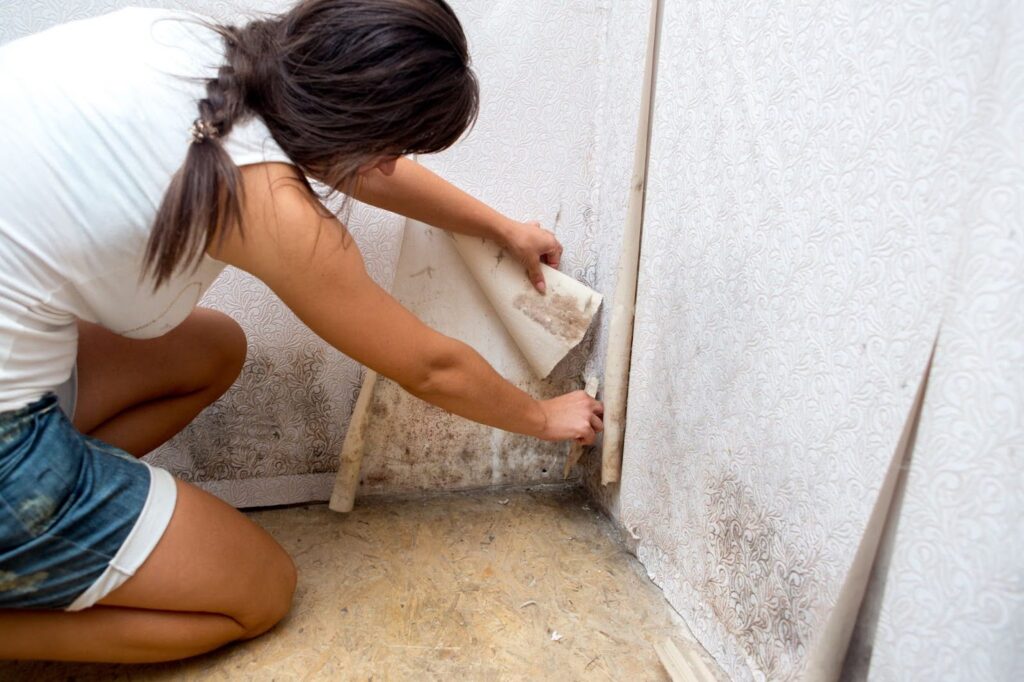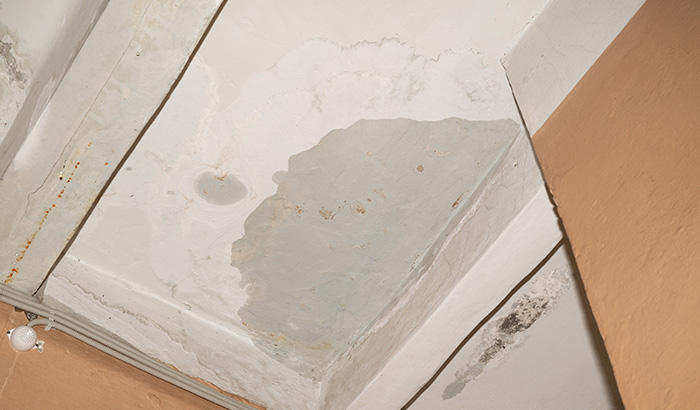Mold in unexpected places is a common issue many homeowners miss, often under the misconception that mold only grows in visible, damp areas. However, mold often thrives in less obvious spots, hidden from plain sight, while still posing significant risks to your health and your home’s integrity. This hidden mold can cause respiratory problems, allergic reactions, and even structural damage over time.
In this blog, we’ll explore various common yet often overlooked areas where mold hides, providing knowledge of where to find mold and how to identify and address these hidden threats effectively. Knowing where to find mold is more than knowing how to keep your house clean; it’s also about protecting your health and home.
Behind wallpaper and paneling
Mold often thrives behind wallpaper and paneling, typically out of sight and mind. This hidden mold grows due to trapped moisture, often resulting from leaks, condensation, or poor ventilation. The space between the wall and the covering creates an ideal, secluded environment for mold to flourish unnoticed.
Detecting mold
Be vigilant for signs like peeling or bubbling wallpaper, a musty smell, or discoloration on the wall’s surface. These suggest the presence of mold behind the wallpaper or paneling. In humid environments or after water damage, it’s wise to inspect these areas more closely so you don’t miss any potential mold growth.
Addressing the issue
If you suspect mold, carefully remove a section of the wallpaper or paneling to inspect the wall behind it. If you find mold, it’s crucial to identify and fix the source of the moisture problem before cleaning or replacing the wallpaper or paneling. For small areas, clean the mold with a mold-killing solution. For larger infestations, it’s best to seek professional help removing mold in unexpected places.
Remember, promptly addressing hidden mold behind wallpaper and paneling can prevent it from spreading and causing more significant damage to your home. Regular inspections and maintenance in these areas help prevent mold growth and keep your living environment healthy.

Under carpets and floor coverings
Mold growth under carpets and floor coverings is a common yet often overlooked problem. Spills, flooding, or even high humidity can trap moisture under these surfaces, creating an ideal environment for mold to grow. Promptly addressing spills and moisture issues is key to keeping your home healthy and mold-free.
Identifying mold
Signs of mold under carpets and floor coverings include a musty odor, discoloration, and dampness. Investigate further if you’ve recently experienced water damage or noticed these signs. Peel back a corner of the carpet or flooring to check for any visible mold or dampness and confirm any suspicions.
Dealing with mold
If you find mold, the first step is to dry out the area completely. Use fans and dehumidifiers to remove moisture. For small mold patches, clean the area with a mold-killing solution like a fungicide. However, if the mold covers a large area or the carpet is severely damaged, you may need to remove or replace the carpet.
After addressing the mold, take steps to prevent future moisture buildup, such as using moisture barriers or improving ventilation.
Inside HVAC systems
Mold growth inside HVAC systems and ductwork is a significant concern that homeowners often overlook. These hidden areas provide a perfect environment for mold to thrive, especially when there is moisture from condensation or leaks. Mold in your HVAC system can spread spores throughout your home, affecting air quality and posing health risks.
Recognizing the risk
Be aware that mold may grow on or near the cooling coils, in drain pans, and within the ductwork of your HVAC system. Signs of mold include a musty odor when the system is running and visible mold around air vents or drip pans.
Regular inspections and cleaning
To prevent mold buildup in your HVAC system, have professionals perform regular inspections and cleaning. They should check for and address moisture issues and clean components prone to mold growth. Regularly changing air filters also helps prevent mold spores from circulating through your home.
Maintaining your HVAC system prevents mold growth and helps it operate efficiently. By being proactive about HVAC maintenance, you reduce the risk of mold growth and its impact on your home’s air quality.
Behind and under appliances
Mold often lurks in hidden places, including behind and under appliances like refrigerators, washing machines, and dishwashers. These areas are prone to mold growth due to moisture from condensation, leaks, or unnoticed spills. The appliances’ warmth and moisture create an ideal breeding ground for mold.
Identifying and preventing mold
Regularly inspect behind and underneath your appliances for any signs of mold or moisture. Look for leaks, standing water, or condensation, as these circumstances could lead to mold development. Keep the areas clean and dry, and immediately wipe up any spills or moisture.
Cleaning and maintenance
Pull appliances away from the wall periodically to clean the floor and wall behind them. Ensure that water lines and drain hoses are securely attached and not leaking. Regularly clean the drip pans for appliances like refrigerators and check that the door seals are intact to prevent condensation.
Incorporating these cleaning and maintenance practices into your routine reduces the risk of mold growth behind and under your appliances. Staying vigilant about moisture in these hidden areas is key to maintaining a mold-free home. Remember, a little effort in regular maintenance goes a long way in preventing mold.
In attics and crawl spaces
Attics and crawl spaces are often hotspots for hidden mold, primarily due to poor ventilation and leaks. These areas are typically out of sight and can harbor moisture problems, creating the perfect conditions for mold growth. Regular inspections and maintenance of your attic and crawl spaces are crucial in preventing hidden mold. By keeping these areas dry and well-ventilated, you significantly reduce the risk of mold growth and protect the overall health of your home.
Identifying mold risks
Poor ventilation in attics and crawl spaces may lead to excess humidity, while leaks from the roof or plumbing often introduce moisture. Be on the lookout for signs of water damage, such as stains or warping, which often indicate a mold problem.
Inspection strategies
Regularly inspect your attic and crawl spaces for signs of mold or moisture. Check for proper ventilation and ensure that vents are not blocked. Look for any signs of roof leaks or plumbing issues, especially after heavy rain.
Mitigation and prevention
To prevent mold growth, address any leaks or moisture problems immediately. Ensure that your attic and crawl spaces have adequate ventilation to reduce humidity levels. Consider installing vapor barriers in crawl spaces to prevent moisture from the ground. Insulating pipes and ducts also help control condensation.

Inside walls and ceilings
Mold growth inside walls and ceilings is often a hidden problem that goes unnoticed until it becomes severe. One of the primary causes of this type of hidden mold is plumbing leaks, which introduce moisture into areas that are not easily visible or accessible.
Regular home inspections, especially in moisture-prone areas, can help you catch and address hidden mold before it becomes a larger problem. Being proactive about leaks and moisture can save you from extensive damage and health risks associated with mold inside walls and ceilings.
Detecting hidden mold
Signs of mold inside walls and ceilings include a musty odor, discoloration, and peeling or bubbling paint or wallpaper. If you notice any of these signs, especially in areas near plumbing fixtures, it’s important to investigate further. Moisture meters are a helpful tool for detecting dampness behind walls or ceilings.
Addressing mold caused by leaks
If you suspect a leak, locate and repair it as soon as possible to stop the source of moisture. Once you have repaired the leak, thoroughly dry out the affected area.
As mentioned before, you can usually clean a small amount of mold yourself. However, if the mold is extensive or you’re unsure about the extent of the damage, it’s best to seek professional help. Professionals can assess the situation and remove mold safely so that it doesn’t spread or cause further damage.
Fight back against hidden mold with Utah Disaster Clean Up & Restoration
Being vigilant about mold in unexpected places helps you maintain a healthy and safe home environment. Hidden mold poses significant health and structural risks. It can cause respiratory issues and allergic reactions and compromise your home’s structural integrity. Regular inspections and prompt action at the first sign of mold are key to preventing these risks.
If you suspect hidden mold in your home or want to ensure your living space is mold-free, don’t hesitate to reach out to the experts. One of our specialties at Utah Disaster Clean Up & Restoration is professional mold inspection and remediation services. Our experienced team uses advanced techniques and equipment to detect and safely remove mold, restoring your home to a healthy state. We know where to find mold and how to get rid of it.
Contact Utah Disaster Clean Up & Restoration for more information or to schedule a consultation. Protect your home and health by addressing hidden mold with the help of professionals.



